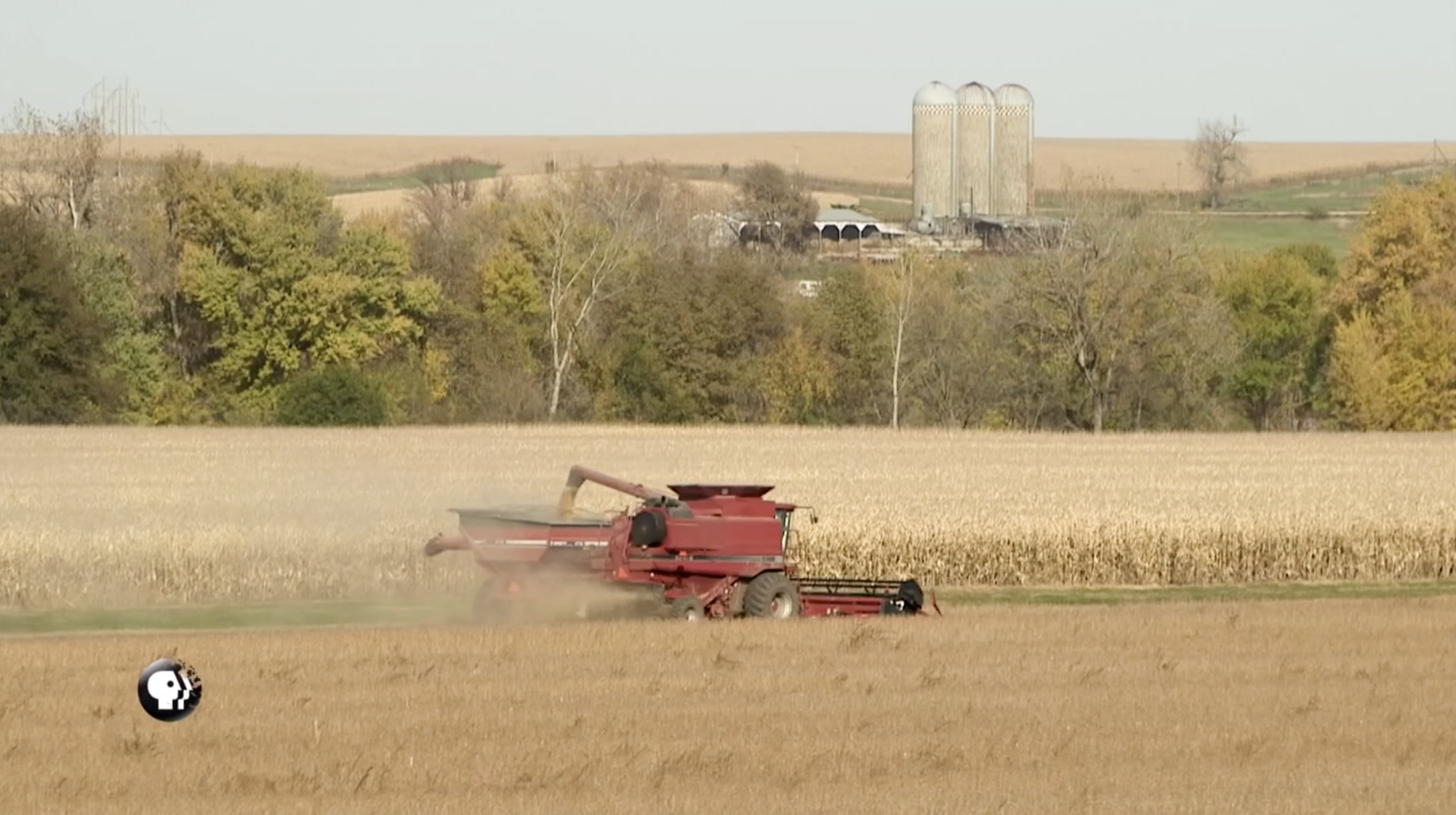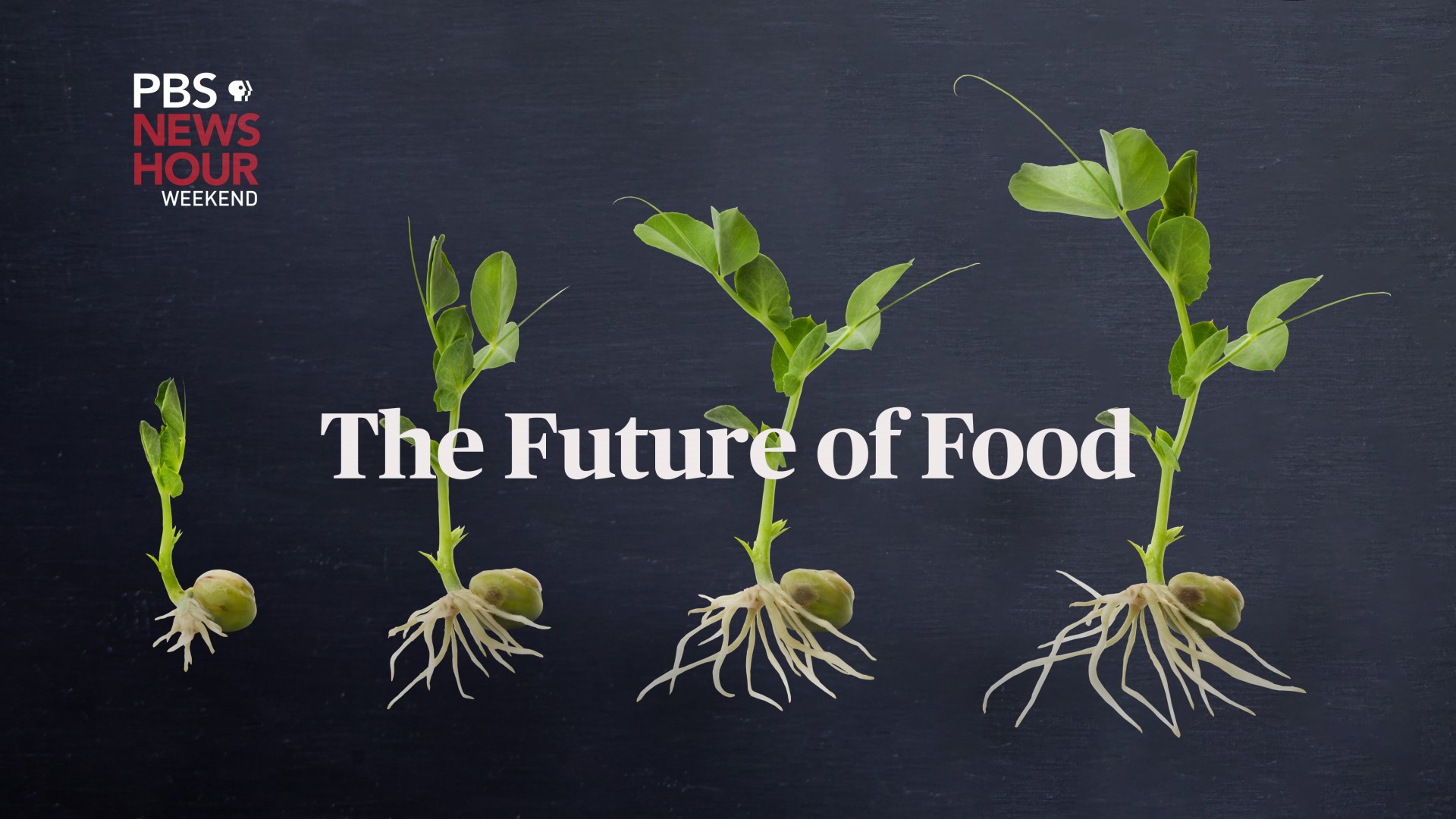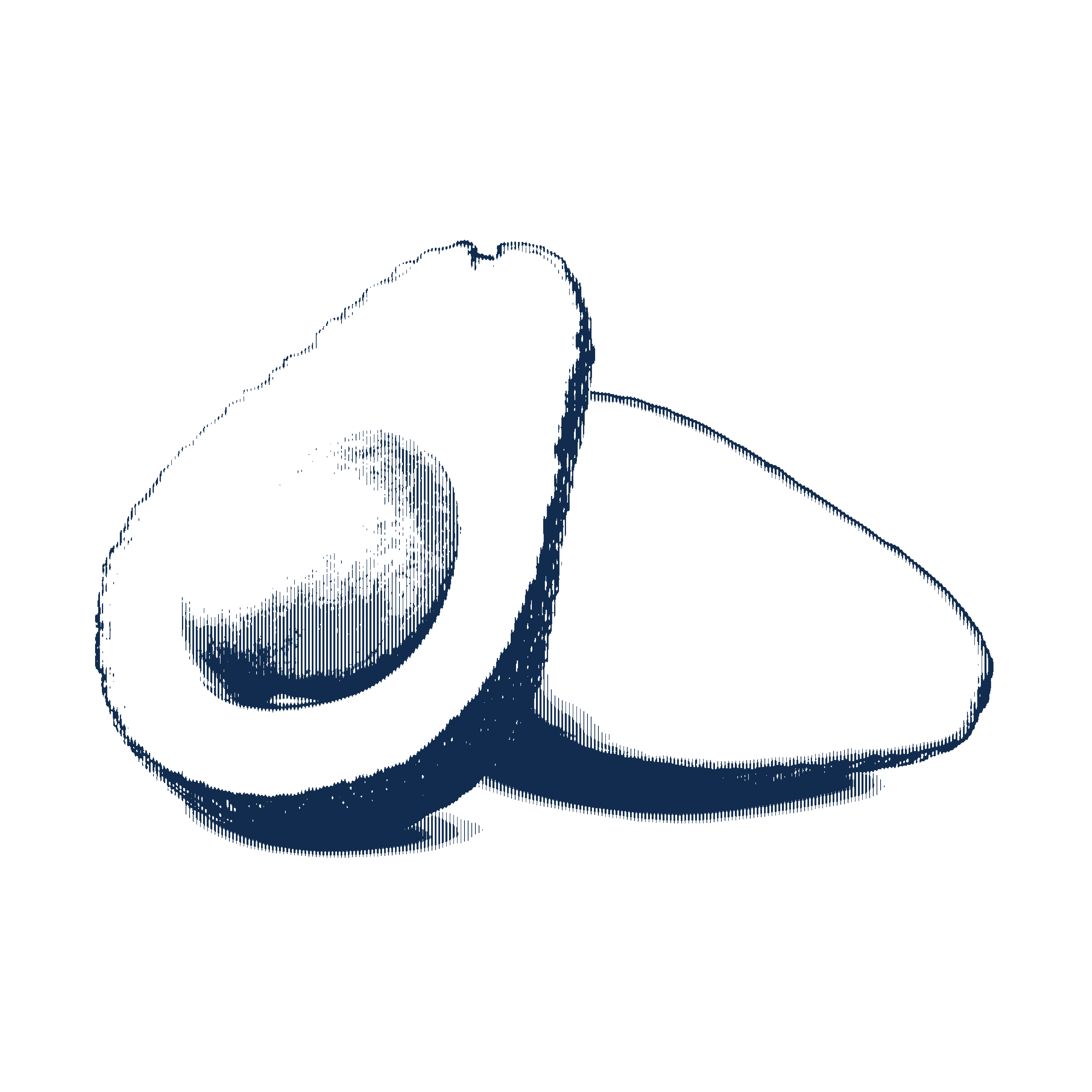
NewsHour Weekend Special Correspondent Mark Bittman reports as part of our "Future of Food" series, supported in partnership with the Pulitzer Center.
Mark Bittman:
It's 90 degrees, a typical July day in Iowa.
Sam Bennett:
Alfalfa was planted this spring, the same time I was planting oats.
Mark Bittman:
Sam Bennett is a sixth-generation farmer — his family's been on this land in Northwest Iowa since 1883. Like most farmers here, he grows mainly corn and soybeans. But today Bennett is showing close to 100 fellow farmers some big changes he's making on his land.
Sam Bennett:
We're gonna harvest probably middle of July. Looks like the rye will be ready before the oats.
Sam Bennett:
We have about 2,000 acres altogether on our farm. We've started integrating small grains like oats and rye into our rotation too. And those really aren't crops that are found really anywhere in Iowa. There's not a lot of acres of those.
Mark Bittman:
This practice of growing a variety of crops — taking a break from the corn and soy beans — is called "diversified crop rotations." Bennett says he plants these crops closer together, so there are more of them. That means more roots in the soil, which improves soil and water quality.
Sam Bennett:
I think my dad comes from a generation that if you work harder you'll be more successful. And I think what I'd like to say in my generation is that if you work smarter, you'll be more successful and taking on some of these newer practices some of these sustainable practices is working smarter.
Mark Bittman:
On most farms, you'll see soy growing in neat, clean rows. But in one of Sam's fields, soy is growing alongside cereal rye. The rye fills in places where weeds would otherwise grow, reducing the need for herbicides.
Mark Bittman:
This rye is a "cover crop" — planted in the fall to protect the fields over the winter, when they'd otherwise be bare. Keeping roots in the ground limits soil erosion and attracts earthworm activity, improving the health of the soil.
Sam Bennett:
Cover crop is building soils. Our earthworms are happy, there's an earthworm hole…
Mark Bittman:
This event is called a "field day." It's a chance for farmers to learn about Bennett's sustainable practices.
Sam Bennett:
I think everybody is always watching me across the fence. I always seem to get a phone call every spring, one guy calls me up, and says what are you doing?
Mark Bittman:
Is he challenging you, or is he digging for info to figure out what he should be doing?
Sam Bennett:
Oh, some of both. I've heard guys say why is your field so weedy? Maybe some of these guys, they've never seen a cover crop field like that before. So, I don't know, I hang those as badges on my chest, I guess, that people are interested in what I'm doing.
Mark Bittman:
It's a pretty significant shift from the status quo. Twenty-three million acres — some 75 percent of Iowa's farmland — is used to grow corn and soybeans, most all of it through what's known as industrial agriculture, using expensive equipment and a massive amount of chemical fertilizers and pesticides. Those two crops are highly subsidized by the federal government, to the tune of hundreds of millions of dollars a year.
And corn and soy are mostly grown to produce ethanol and animal feed. The remainder that's eaten by humans is mostly in the form of junk food.
Sarah Carlson is the strategic initiatives director at Practical Farmers of Iowa, or PFI.
Sarah Carlson:
Nature doesn't like all that specialization, right. Nature wants chaos. Nature wants diversity.
Mark Bittman:
PFI is a farmer-led non-profit organization that researches conservation practices, shares the findings with its members like Sam Bennett, and then gets them to spread the word to other farmers.
Mark Bittman:
When people think of Iowa, the reality is it's not much more than corn and soybeans. Is that a problem, or if it is, why is that a problem?
Sarah Carlson:
So because of the cropping system that we have today where we just plant two crops for about six months out of the year. We have no roots in the ground in the wintertime. And so we have a lot of chance for water to take pollutants into nearby water bodies.
Mark Bittman:
Pollutants called nitrates — found naturally in soil and also contained in fertilizers — have contaminated Iowa's drinking water supply. It's costing hundreds of millions of dollars to clean it up.
Sarah Carlson:
Also we have increased flash flooding because we aren't holding water on the landscape like we used to.
Mark Bittman:
Record flooding earlier this year left swaths of farmland throughout the midwest too wet to plant, threatening many farmers' livelihoods.
Sarah Carlson:
So there's just a whole host of externalities because of the two-crop system.
Mark Bittman:
Meanwhile, farmers' practices are slowly starting to change, thanks to more awareness, government incentives and training by groups like the Practical Farmers. Its membership has more than doubled in the last seven years. And the use of cover crops has surged in this state, tripling over the last five years to around 900,000 acres today. Carlson points out that, ironically, many of these practices used to be common. Industrial farming of corn and soy is actually a relatively new phenomenon.
Sarah Carlson:
We haven't always looked like this. Even three decades ago, farmers in this area would have been growing small grains in rotation with a legume cover crop and corn and some soybeans.
Matt Liebman:
Iowa used to produce a huge amount of horticultural crops. So it produced apples and grapes and tomatoes.
Mark Bittman:
Matt Liebman is a professor of agronomy and researcher at Iowa State University.
Matt Liebman:
So the Iowa landscape began to transform dramatically in the 20th century, and with development of farm chemicals and machinery, crop rotations got much less divers. And enormous increases in productivity took place, and that's what we're living with today, a highly mechanized, extremely specialized, highly productive, narrow diversity system.
Mark Bittman:
This highly mechanized system is depleting Iowa's topsoil, the most nutrient-rich layer. About half of it has already disappeared. Liebman is researching ways to combat the destruction, by growing something called "prairie strips" — plots of native grasses and wildflowers, planted along-side traditional crops.
Matt Liebman:
There's something covering the ground year-round. And these plants have stiff upright stems that serve as ways of filtering the water flowing across the land, slow it down. There's a lot of vegetation here, so there's essentially no run off of prairie.
Lee Tesdell:
I have been called an outlier. I would say I'm doing things that almost no one else in the neighborhood would do.
Mark Bittman:
Lee Tesdell is one of about 70 people working with Iowa State University to grow prairie strips. Tesdell owns 80 acres in central Iowa, and uses 20 for various conservation practices, including a "saturated buffer," a filter that keeps nitrates from running into a nearby stream.
Lee Tesdell:
This is a relatively inexpensive way to denitrify water.
Mark Bittman:
The stream is what you're protecting.
Lee Tesdell:
Right. We're trying to protect water quality for people downstream.
Mark Bittman:
Tesdell says the buffer has decreased nitrate runoff by 91 percent. Many of his sustainability practices were paid for by a combination of private, state and federal programs. But Tesdell did have to pay for some of it out of pocket.
Mark Bittman:
I'm making some assumptions here, but you're not a flaming radical farmer. These aren't especially radical notions. But they're not super common either.
Lee Tesdell:
Right. Part of it's the cost, however it's important to know that in Iowa 60% of the farmland is not farmed by the owner.
Mark Bittman:
Tesdell himself doesn't farm his land — that job falls to Mike Helland.
Lee Tesdell:
If the landowner isn't working together with the tenant on conservation, it's probably not going to get done.
Mark Bittman:
Because the tenant has less interest in stewarding the land than the owner would.
Lee Tesdell:
Exactly.
Mark Bittman:
And this creates a huge barrier to change. Since many farmers don't own the land, they don't feel invested enough to make long-term changes, especially ones that might impact their bottom line. And even if they wanted to farm more sustainably, some landlords might not allow it.
Lee Tesdell:
Mike and I always say that we're trying to be an example in the neighborhood. And that our neighbors are watching us.
Mark Bittman:
Mike Helland farms about 3,000 acres, renting 2,400 of them from various landlords. Helland is open to trying more conservation techniques. But, he already tried a diversified crop rotation of oats in the 80s…
Mike Helland:
There's an old saying in oats: It's one of the most consistent crops in Iowa; it'll lose money every year.
Mark Bittman:
He says it didn't work then and won't work now for him, because big food companies have set up their systems to source specific crops from a few specific locations, like buying oats from Canada or wheat from Kansas.
Mike Helland:
It kind of goes back to economics. We don't even have a market, around here, for wheat. I mean, I couldn't call up my local elevator and say I want to bring in wheat, they don't have any place to put it.
Mark Bittman:
Helland also says making a living as a farmer is getting harder. He's already invested over one million dollars in machinery and equipment, while corn and soy prices have dipped in recent years.
Mike Helland:
All of our costs keep going up. As a farmer, you never get a cost of living increase, you just have to be more efficient, with the same machinery, or the same manpower, same hours.
Mark Bittman:
So farmers feel trapped in this system. But despite all the hurdles, people like John Ikerd say we don't have a choice but to change. Ikerd is an agricultural economist who spent 30 years working with farmers across the u.S.
John Ikerd:
I can't tell you how long we can continue to prop up this unsustainable agriculture, but we can't do it indefinitely.
Mark Bittman:
What does a sustainable food system look like?
John Ikerd:
It's about looking at agriculture as a part of a living system. Because it's all interconnected. And so you have to have farming systems then that are in harmony with nature, with natural principles; the regenerative, resilient, diverse natural ecosystems have to be reflected in the farms.
Mark Bittman:
So what will it take to make the large-scale changes experts believe need to happen? PFI's Sarah Carlson says food companies can create markets for alternative crops. And state and federal governments must increase sustainability requirements in farming programs.
Sarah Carlson It might be through finance, it might be through mortgage rates, you know, might be through the market, it might be through crop insurance. So we've got to try all of those things and see what gets the, gets the shift the fastest. If we care about farmers on the landscape and we care about rural communities then we need to kind of make a wholesale change in the way we do business and the way we support agriculture in general.
Mark Bittman:
But all of that is a long way off. For now farmers like Sam Bennett are implementing solutions crop by crop, acre by acre.
Mark Bittman:
With any luck, you're going to be farming for 50 years. Do you think it will look different in 20, 30, 40 years from now? What do you envision?
Sam Bennett:
I sure hope it looks different. I'd like to see more diversity on the landscape, diversity that we had 50 years ago. What used to be normal I'd like to make normal again. It's like I told 100 people what I'm doing today. If those 100 people tell 100 people, we'd solve this problem real quick. I'm not borrowing this land from my dad, or my grandpa, I'm borrowing it from my kids, and my grandkids. It's my responsibility to leave this land in better shape than I found it.








